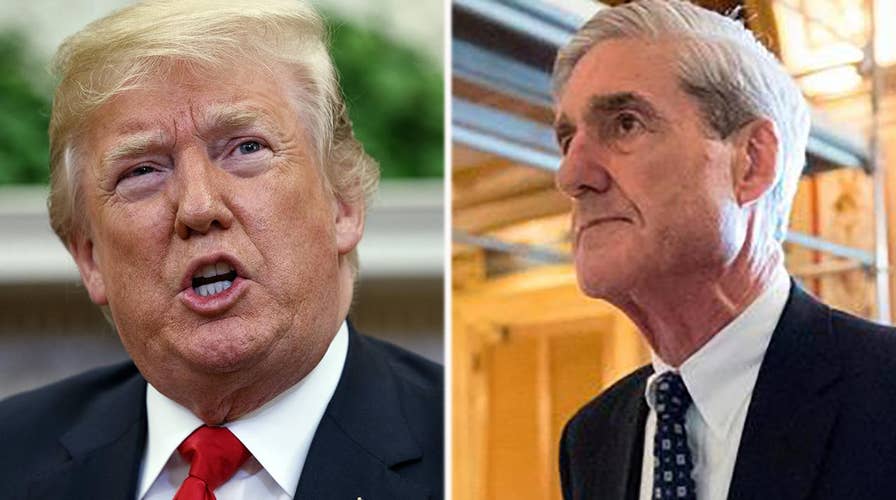President Trump: Mueller probe 'not even constitutional'
President Trump says Special Counsel Mueller's Russia investigation is 'unconstitutional'; chief national correspondent Ed Henry reports.
Over the past year, President Trump has reportedly considered and then denied intentions to find a way to fire Special Counsel Robert Mueller and stop his investigation into Russian meddling in the 2016 presidential election, allegations that the Trump campaign worked with the Russians, and other topics.
Muller’s investigation has so far led to more than a dozen criminal indictments and three guilty pleas, including by President Trump’s former national security adviser and his former deputy campaign manager. Presumably, President Trump is calculating whether getting rid of Mueller could save the president from further legal and political scrutiny, including of his financial dealings.
Firing Mueller would trigger a constitutional crisis like we haven’t seen since Watergate. But such an action would nevertheless leave two dozen key players intact.
These key players include the 23 ordinary Americans making up the federal grand jury charged with evaluating the evidence that Mueller has been presenting to them for months. The 24th player is Chief U.S. District Judge for the District of Columbia Beryl A. Howell, who impaneled the grand jurors and is the only person who can discharge them.
These 24 individuals are precisely the kind of people our nation’s founders wanted to hold powerful officials to account and protect their fellow citizens from wrongdoing.
A new Issue Brief by my organization, Constitutional Accountability Center, explores the evolution of the federal grand jury in America from its placement in the Bill of Rights as a key component of the Fifth Amendment, through its role in the present day.
It’s true that grand juries no longer have or exercise the power they once did. But today’s grand juries – including the group assessing the evidence presented by Special Counsel Mueller – have a latent potency that, with the permission of Chief Judge Howell, could play a surprising role in how the investigation ends, even without the special counsel.
At the founding of our nation, grand juries had broad authority to investigate possible crimes by public officials and others, and could issue indictments that prosecutors were bound to pursue.
As James Wilson – one of the architects of our Constitution, and a signer of the Declaration of Independence – once explained: “The grand jury are a great channel of communication, between those who make and administer the laws, and those for whom the laws are made and administered. ... They may expose to publick inspection, or to publick punishment, publick bad men, and publick bad measures.”
A prominent example of grand jury power at the state level was exercised in 1872, at the expense of the corrupt Tweed Ring of New York’s Tammany Hall.
William M. “Boss” Tweed and his ring controlled “nearly every lever of power in New York City … and used their power to funnel public money for their own personal gain.” It was a grand jury that brought them down.
Using its “broad authority to subpoena witnesses and books” and “obtain evidence (of corruption) in spite of the elaborate efforts of Tammany politicians to hide their operations,” this grand jury performed the function that founders like Wilson envisioned.
Almost 80 years after that, however, Congress changed the federal Rules of Criminal Procedure governing the operation of federal grand juries, curtailing their power to independently indict.
In the decades since, federal grand juries have been far less likely to carry out their own investigations or to write reports about their findings, mostly due to the increasing complexity of criminal law. Importantly, however, these traditional powers have not been eliminated.
Chief U.S. District Judge for the District of Columbia John Sirica, we must remember, presided over a grand jury investigating the Watergate scandal in 1974 that wrote a report on its findings. The grand jurors requested that Sirica release their report to the House Judiciary Committee for consideration as part of its impeachment proceedings against President Nixon.
Sirica did just that, concluding that “grand jury prerogatives extend to the presentation of documents that disclose evidence the jury has gathered but which do not indict anyone,” and that “grand juries have historically published reports on a wide variety of subjects.”
That is the model that President Trump and his advisers should keep mind when considering whether to fire Mueller. A grand jury without Mueller might still have amassed enough evidence over the months to produce a report of its own that would be an important compilation of the information grand jurors learned, with any conclusions they could draw from it.
In turn, Howell has the power to release such a report in an appropriate manner. She could, for example, release it to the Senate Intelligence Committee, which is running its own investigation into Russian meddling in the 2016 election, co-led by Republican Sen. Richard Burr of North Carolina and Democratic Sen. Mark Warner of Virginia.
As a result, if Mueller is fired, what happens with the investigation he’s been running will largely be up to people President Trump cannot fire: the grand jurors and Chief Judge Howell.
While modern federal grand jury rules curtail their options to a degree, the actions of the grand jurors nonetheless could be incredibly potent. Before firing Mueller, President Trump would do well to remember that. Try as he might, he might find that he has no choice but to face the music – one way or another.





















